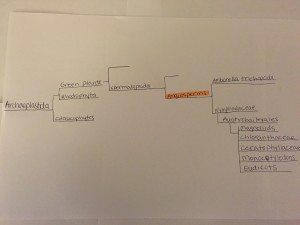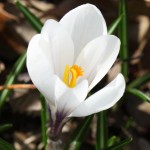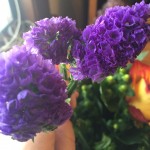Phylogenetic Tree of Life
There are four supergroups of Eukaryotes and they include the Unikonts, the Chromalveolates, the Excavates, and the Archeaplastida. Archeaplastida are also called Plantae, and is the supergroup that the angiosperms belong to.
Archeaplastida contains three major lineages including Glaucophytes (microalgae), Rhodophyta (red algae), and the lineage that contains angiosperms, the Green Plants (Hedges & Kumar, 2009). The lineage of land plants stem from the Green Plants and are known as the Embryophytes. Sixteen different lineages stem from the Embryophytes, but the group that the angiosperms belong to are the Spermatopsida. Spermatopsida contain groups such as the conifers, seed plants, and flowering plants (Hedges & Kumar, 2009).
Analysis in the last five years has led scientists to agree that Amborella is the base of the angiosperm’s evolutionary tree. Major groups that branch off from Amborella trichopoda are Nymphaeaceae (water lilies and relatives), Austrobaileyales, Magnoliids, Chloranthaceae, Ceratophyllaceae, Monocotyledons (lilies, orchids, grasses), and eudicots (most flowering plants).
The order of taxonomic hierarchy for angiosperms is ranked: Eukaryote, Archeaplastida, Green Plants, Embryophytes, Spermatopsida, Angiosperms. Angiosperms contain at least 260,000 living species which are classified into 453 families and over 904,649 species (Hedges & Kumar, 2009).
See photo gallery below for some examples of these species.
- Crocus (Crocus sativus)
- Clover (Trifolium repens)
- Rose (Rosa chinensis)
- Zebra Succulent (Haworthia attenuata)
- Statice (Limonium sinuatum)
- Cherry Blossom (Prunus serrtula)
- Orchid (Phalaenopsis amabilis)
- Sunflower (Helianthus annuus)
Above is a Photo Gallery exampling some species in order to show the wide range of diversity in Archaeplastida. (Photos by Alyssa Riddle)
Fossil Evidence and the Molecular Clock

This timeline represents the estimated divergence of the kingdom Plantae. This diagram displays the diversification of various lineages and their relationships to the Angiosperm clade. The timeline is based upon molecular clock data provided by Hedges, Blair, and Kumar through the Timetree of Life project (2009). Created by Emily Thomas.
Fossil and molecular clock evidence agree that angiosperms are the most recently evolved of the major groups of plants. Both bodies of evidence also agree that the clade diverged from their sister group the gymnosperms, the cone-bearing plants (“Angiosperms,” 2008).
The timing of this divergence is not fully resolved by the fossil record and molecular clock estimates. The lack of a comprehensive fossil record has led to molecular clock evidence as more widely accepted by the scientific community. This evidence suggests that angiosperms arose approximately 175 million years ago (Hedges & Kumar, 2009). The hypothesized phylogenetic and chronological relationships of angiosperms to gymnosperms, as well as the other plant lineages, based on molecular clock evidence, are see in the figure to the right.
Angiosperm Fossil Evidence
The most definite evidence of angiosperms in the fossil record comes from Cretaceous era fossils are the most definite evidence . The fossil record of angiosperms display a wide variety of structures, shape, and size. The vast morphological diversity has made it difficult to resolve relationships between the major angiosperm clades, but shows early diversification of lineages (Soltis, Soltis, & Edwards, 2005). Fossilization of leaves, pollen, wood, and floral structures have allowed for character based analysis of evolution (Dilcher, 2000). While fossil evidence has provided a basic understanding of angiosperm diversity throughout time, scientists must rely on the combination of preserved specimen’s physical and genetic characteristics to develop a more definite understanding of the angiosperm clade and relationships among it’s lineages.

This timeline represents the estimated time of diversification of the angiosperm clade. Based on molecular clock data (Hedges & Kumar, 2009), the diagram shows the rapid diversification of angiosperms. This diversification occurred in a relatively short geological time frame (approx.. 40 million years). Created by Emily Thomas.
Molecular Clock
While molecular clock evidence is the most widely used for examining phylogenetic relationships, complications arise in using molecular clock evidence for plants because of inconsistent evolution rates among different lineages (Dilcher, 2000).
Molecular clock evidence predates fossilization records for angiosperms by approximately 50 million years (Soltis, et. al, 2005). This unifies the angiosperm clade as a monophyletic group, defined by one evolutionary event, but does not fully resolve relations between other plant lineages. (Hedges & Kumar, 2009).
Within the angiosperm clade there are 5 major extant groups (Eudicots, Ceratophyllales, Monocots, Magnoliid, Chloroanthales) and 3 other “primitive” (non-extant) groups (Austrobaileyales, Nymphaelales, and Amborellales) (Hedges & Kumar, 2009).
The major divergences amongst these groups are represented in the phylogenetic timeline above. Molecular evidence suggests the first divergence within the clade was the Amborellales approximately 174.9 mya. The Nymphaeales diverged approximately 167.3 mya. The Austrobaileyales diverged 159.5 mya, the Chloroanthales 150.1 mya, and the Magnoliids 147.8 mya. The most recent divergences were of Monocots 146.6 mya, and the Ceratophyllales 146.3 mya (Hedges & Kumar, 2009).
Evolutionary Innovations
Over time, specific evolutionary features, have distinguished angiosperm reproduction. The development of non-exposed seeds, housed within a flower structure, defines the group. This evolutionary feature has led to an abundance of morphological variation and widespread distribution of this group. Angiosperm flower structures have evolved in response to ecological pressures rapidly, and this success has led to the group’s survival, nearly universally, across the diverse ecosystems of our planet (Carter 1997).

Spider Wasp, under a dissection microscope. This organism is a common pollinator and of the family Pompilidae. Photo by Nick White.
Flowers come in an astounding number of colors, shapes, sizes, arrangements, and smells. All of these are evolutionary innovations which assist in attracting pollinators. Attraction is effected by color, scent, and the production of nectar, which may be secreted in some part of the flower. Pollinator’s relationship with their flowers are a textbook example of coevolution, as some animals evolve specifically to cater to a flowers pollination needs. These animals transport the flowers pollen to a wider geographic range to give them an excellent diversity within the population. (Carter, 1997)
Flower organs help to facilitate the reproductive cycle of angiosperms.
Each flower part has a specific function.

A labelled, bisected specimen of the Erigeron glaucus, more commonly known as the Daisy. The reproductive (carpel, stamen, anther, and sepals) and non-reproductive structures (receptacle and pedicel) of the flower are displayed. Photo by Nick White.
Pedicel: The stalk of the flower
Receptacle: The part of the stalk where the various parts of the flower are attached
Sepal: Acts as the base for the flower
Petal: Aids in attracting pollinators
Stamen: The male part of a flower
Anther: The part of the stamen where pollen (male gametophytes) is made
Carpel: Houses female gametophytes

Example of the most commonly cultivated fruit, the citrus fruit of a Rutaceae, commonly called an orange. Photo by Nick White.
After fertilization, the ovule transforms into a seed, and it is surrounding tissues evolve into a fleshy fruit. The fruit protects the seed and also promotes it’s dispersal to a wide geographic range. Much like flowers, fruit also has a large diversity among species. Some is meant to be dispersed by the wind, but many rely on animals to disperse it. Whether by having hooks to hook on to an animal’s skin or fur or being sweet and nutrient rich to promote being eaten, digested, and fertilized by the animals that carry them off (Carter, 1997).
References
Angiosperms. (2008). In L. Lerner & B. Lerner (Eds.), The Gale Encyclopedia of Science (4th ed., Vol. 1, p. 217). Detroit: Gale.Carter, J. (2014, January 17). Angiosperms. Retrieved March 6, 2015, from http://biology.clc.uc.edu/courses/bio106/angio.htm
Hedges, S., & Kumar, S. (2009). Plants. In The Timetree of Life (pp. 133-137, 162-165). Oxford: Oxford University Press.
Soltis, D., Soltis, P., & Edwards, C. (2005, June 3). Angiosperms: Flowering Plants. Retrieved March 6, 2015, from http://tolweb.org/Angiosperms/20646/2005.06.03









Thanks for your post. All plus size bell bottom jeans here